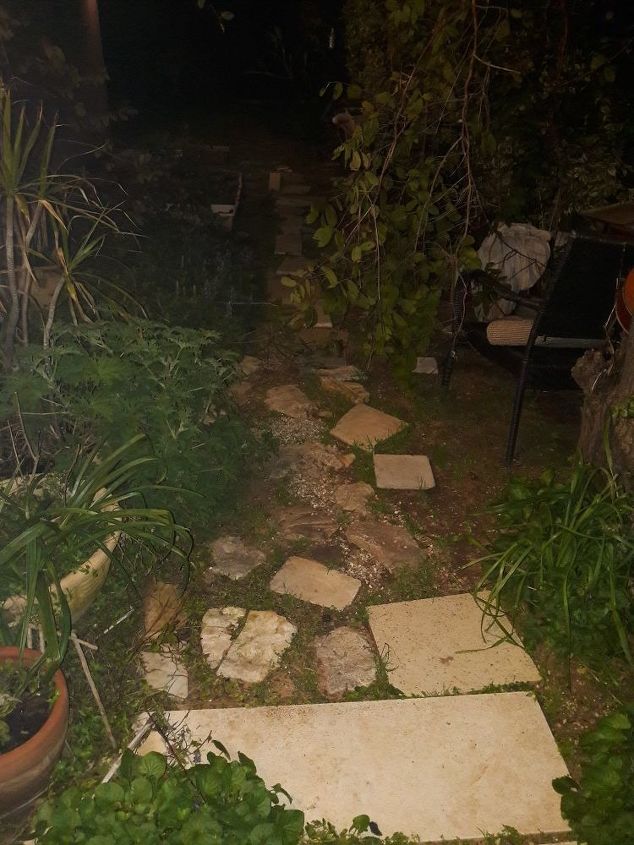How do i make a path of stones & pottery embedded in cement?
Related Discussions
GNATS - How to get rid of them?
Somehow my house and garden got tiny gnats that killed my fuchsia plant and fly everywhere. I have tried ALL the Web recommendations - soap and oil dishes, sand in th... See more
Marigolds growing! Should I pinch the buds?
My marigold plants are growing. I heard that pinching the buds until Autumn will allow them to grow without killing the plant. Is this true?
Growing garlic
Growing our first garlic, should we wait until the leaves are drying out before we pick it? Husband picked first one today along with our first potatoes.
How to keep mice out of your garden?
Hi everyone, I have mice in my garden destroying my vegetables and I have also noticed them in the barn and shed. Please can someone tell me how to prevent them from ... See more
What's the best flower/plant to grow in Texas?
I know that opinions vary, but what's your opinion?!I have great luck w Rosemary plants. Green all year long.
How do I make dollar Store stepping stones?
Some nice lady made some outdoor decorations using stepping stones and the basket paper plate holders. She sprayed the baskets and then glued the stones to them and ... See more
Best way to kill bush/tree after being cut down?
Just moved into a new home. There was a huge thorny bush dragon devouring the mailbox. I slayed the dragon but it is trying to rise up again. How can I make sure it's... See more





See if this helps!
http://homeguides.sfgate.com/embed-rocks-concrete-51661.html
https://books.google.com/books?id=st4fAQAAMAAJ&pg=PA785&lpg=PA785&dq=how+to+make+a+cement+path+embedded+with+various+items&source=bl&ots=knKdICPsHh&sig=heWgn0uSTyFMa8viLIEQcdqcBEk&hl=en&sa=X&ved=2ahUKEwia__L-prXZAhVnwVQKHWNBABQ4FBDoATAIegQICRAB#v=onepage&q=how%20to%20make%20a%20cement%20path%20embedded%20with%20various%20items&f=false
It would take a good bit of work to do cement, digging, leveling, sand, gravel, forms, tamping. With a continuous concrete slab things shift over time cracking a large slab. You could make smaller slabs with a 2 X 4 frame in smaller squares like 12" x 12" with all of your pieces set in them, making smaller stepping stones. Dig to a depth to bury you slabs in and pour pea gravel and tamp lightly. Use a base of felt paper sheeting that you use for under shingles on the roof and put your sand on top of that, then snug your concretes squares you made on top of that into the sand so they asre level with the surrounding dirt. The felt paper helps the sand from flushing away and the sand lets the concrete shift on it's own with less breakage when the weather changes. they are easy to straighten simply by lifting and shifting the sand to level again.
Lift up existing stones, Firm ground Peg out line of Path and section it to make workable areas. Start at the furthest from the house. Mix and lay concrete , allowing for the tiles/slabs etc to be added with a mortar mix later. Continue in this manor until all pathway has been concreted. Dividing it into sections allows you to be able to do as much or as little in one go as you wish. Once concreting is complete leave to cure, then start at the farthest point again and lay on a mortar mix the tiles /stones /slabs etc. (This can be done in one go, but doesn't have to be. Leave again as long as you can to cure, then remove the Shuttering you pegged in and put the earth or Back in place. That's it......
Trace around the stones with spray paint. Then remove the stone and dig down until the stone will be ground height. Put the stone back it should not move now.
Agree with what both Em and Johnavallance82 said. Yes, it is a lot of work, but sometimes there is no alternative to doing a job the correct way if you want the results to last over time, to be durable, and to look attractive.
Thanks all! Have to rethink my plan. Really sounds like a lot of work...
1) dig up everything that's in there, correct anything you don't like about the path of the path, and level the depression (now is the time to think about drainage if water tends to pool around this area) . figure out a standard thickness (based on the thickest pieces) create 'paving stones' using the thin stuff (either mosaic on bought pavers, or pour your own, embedding bits of crockery) let them cure, lay them in the path, and backfill with paver (polymeric) sand.
2) same process, but build a series of forms, pour a form, embed stuff in the wet concrete, let set, repeat
3) find a pro willing to work with your bits and pieces (you can lay out mosaic patterns, cover the faces with contact paper, and make a fairly easy transfer to the wet concrete)
Thank u, Jean, for your detailed suggestions! U gave me hope ⛙🔥